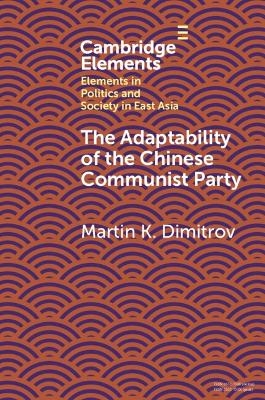
The Adaptability of the Chinese Communist Party
Seiten
2025
Cambridge University Press (Verlag)
978-1-009-18443-4 (ISBN)
Cambridge University Press (Verlag)
978-1-009-18443-4 (ISBN)
- Noch nicht erschienen (ca. April 2026)
- Versandkostenfrei innerhalb Deutschlands
- Auch auf Rechnung
- Verfügbarkeit in der Filiale vor Ort prüfen
- Artikel merken
The Chinese Communist Party celebrated its one-hundredth birthday in 2021. Its durability poses a twofold question: How has the party survived thus far? And is its survival formula sustainable in the future?
The Chinese Communist Party (CCP) celebrated its one-hundredth birthday in 2021. Its durability poses a twofold question: How has the party survived thus far? And is its survival formula sustainable in the future? This Element argues that the CCP has displayed a continuous capacity for adaptation, most recently in response to the 1989 Tiananmen protests and the collapse of communism in Europe. As the CCP evaluated the lessons of 1989, it identified four threats to single-party rule: economic stagnation; socioeconomic discontent; ideological subversion; and political pluralism. These threats have led to adaptive responses: allowing more private activity; expansion of the social safety net; promotion of indigenous cultural production; and rival incorporation into the party. Although these responses have enabled the CCP to survive thus far, each is reaching its limit. As adaptation stagnates, the strategy has been to increase repression, which creates doubt about the ongoing viability of single-party rule.
The Chinese Communist Party (CCP) celebrated its one-hundredth birthday in 2021. Its durability poses a twofold question: How has the party survived thus far? And is its survival formula sustainable in the future? This Element argues that the CCP has displayed a continuous capacity for adaptation, most recently in response to the 1989 Tiananmen protests and the collapse of communism in Europe. As the CCP evaluated the lessons of 1989, it identified four threats to single-party rule: economic stagnation; socioeconomic discontent; ideological subversion; and political pluralism. These threats have led to adaptive responses: allowing more private activity; expansion of the social safety net; promotion of indigenous cultural production; and rival incorporation into the party. Although these responses have enabled the CCP to survive thus far, each is reaching its limit. As adaptation stagnates, the strategy has been to increase repression, which creates doubt about the ongoing viability of single-party rule.
1. Introduction: The Adaptability of the Chinese Communist Party; 2. Economic Reform; 3. Extending the Social Safety Net; 4. Protecting Cultural Security and Promoting Indigenous Cultural Consumption; 5. Rival Incorporation into the Chinese Communist Party; 6. Conclusion.
| Erscheint lt. Verlag | 1.4.2026 |
|---|---|
| Reihe/Serie | Elements in Politics and Society in East Asia |
| Zusatzinfo | Worked examples or Exercises |
| Verlagsort | Cambridge |
| Sprache | englisch |
| Themenwelt | Sozialwissenschaften ► Politik / Verwaltung ► Politische Systeme |
| Sozialwissenschaften ► Politik / Verwaltung ► Staat / Verwaltung | |
| Wirtschaft ► Volkswirtschaftslehre ► Wirtschaftspolitik | |
| ISBN-10 | 1-009-18443-1 / 1009184431 |
| ISBN-13 | 978-1-009-18443-4 / 9781009184434 |
| Zustand | Neuware |
| Haben Sie eine Frage zum Produkt? |
Mehr entdecken
aus dem Bereich
aus dem Bereich
über Alltagsorte des sozialen Zusammenhalts
Buch | Softcover (2024)
transcript (Verlag)
24,00 €


